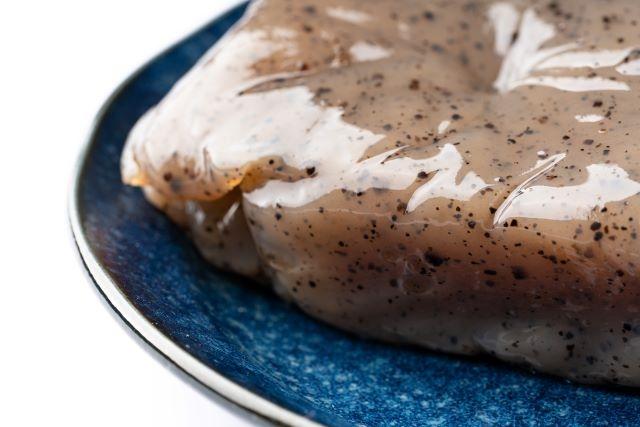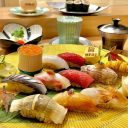
Japan has one of the lowest obesity rates in the world and a good part of that has to do with the food. A traditional Japanese diet is well balanced with lots of vegetables and fish and less red meat. Overall, the traditional diet is low in calories but very nutritious. That said, there are a number of foods that may seem strange to people in other countries but also come with a lot of health benefits. Let’s take a look at some of the more unusual foods below.
1. Konnyaku
Konnyaku is a popular food made from konjac, a type of yam grown throughout Asia. It typically has the appearance of a brown or grey jelly-like cube though it is also sometimes made into noodles. It’s been consumed in Japan since the 6th century and is regarded as good for health due to its very high fibre content. While Konnyaku itself has little flavour on its own, it’s valued for its texture and is often used in oden or hot pots. In Japan, it typically comes in either a white or grey variety. Konnyaku is also considered a great food for dieting as it is extremely low in calories.
2. Natto
Possibly the most infamous food on this list, natto has been consumed in Japan for more than a thousand years. Natto is made from cooked, fermented soybeans mixed with good bacteria. Natto is mainly eaten as a breakfast food with rice and miso soup. Natto is famous for its unique taste, sticky texture and strong smell. These usually make it something you either love or hate. High in protein and vitamins, natto is great for maintaining healthy skin and dealing with fatigue. As it also contains probiotics, it’s good for digestion. Eating natto every morning can improve overall health and even people who don’t like the taste sometimes consume it for its many benefits.
3 neba-neba Japanese foods that you would have NEVA tried before
3. Mentaiko
A specialty of Fukuoka prefecture but popular all over Japan, mentaiko is a dish made of salted cod roe seasoned with different herbs and spices. Depending on the manufacturer, mentaiko comes in a variety of reddish colours from pink to bright red. Most Japanese people eat it raw with rice however there are many different ways to eat it that really accentuate its unique flavour. Mentaiko pasta is especially popular and it’s also a popular filling in bread and onigiri. Mentaiko is high in vitamin B12 and omega 3 fatty acids.
4. Tororo-rice
Tororo is made from a type of raw mountain yam, grated down to form a sticky paste full of vitamins and minerals. Served on top of rice it makes a simple, filling dish that’s full of fibre and is said to prevent high blood pressure and give you beautiful skin. It’s a popular Japanese rice dish with a surprising amount of health benefits. Though its sticky texture may be off-putting for some, it’s a great, healthy way to begin your day.
5. Umeboshi
Often seen on top of a freshly cooked bowl of rice or inside an onigiri, umeboshi are pickled Japanese plums. They have a strong sour taste that contrasts with the rice though there are also sweeter variations. They typically contain 3-6 calories each and are believed to aid with digestion and help with fatigue.
6. Shiokara
Shiokara is a dish made from various seafood such as squid, tuna or oysters fermented in their own internal organs. It has an extremely strong flavour and is often served in bars as an accompaniment to alcohol. It can be a challenge to eat but is said to be great for blood circulation and anti-aging.
7. Umi budo
Umi budo is literally translated as ‘sea grapes’ and is a kind of seaweed that is popular in Okinawan cuisine. Okinawans have one of the longest life expectancies in the world and are known for their good health throughout Japan. Umi budo is shaped like tiny grapes so it’s easy to see where it gets its name from. It’s also known as green caviar in some other countries due to this shape. Umi budo is usually eaten with sushi or as a salad topping but it’s also popular as a snack eaten by itself along with a vinegar based dip. Umi budo is a great source of vegetable protein and antioxidants.
8. Shirako
One of the more unusual dishes on this list, Shirako, translated as “white children”, is fish sperm originating from a variety of fish including salmon and cod. Usually served raw as a sushi type dish, it can also be cooked in many different ways depending on the restaurant. Knowing what it is can scare non-Japanese tourists off but it has a soft, runny texture and apparently, a creamy, rich taste. It is said to be good for healthy skin and contains omega 3 which is great for your health.
Some of these foods may have some strange qualities but it’s a fact that they’re great for your health. If you’re looking to add some variety to a healthy lifestyle, why not give some a try?
— Article From BACK LANE











